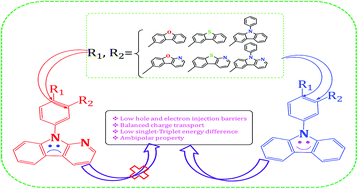Quantum chemical design of carbazole- and pyridoindole-based ambipolar host materials for blue phosphorescent OLEDs†
Abstract
Density functional theory has been employed to design thirty two host molecules for blue electrophosphorescence by incorporating dibenzofuran (DBF), dibenzothiophene (DBT), phenylcarbazole (Ph-Cbz), benzofuropyridine (DBF), benzothiopyridine (BTP) and phenyl pyridoindole (Ph-Cb1) subunits into N-phenyl carbazole (Ph-Cbz) and phenyl α-carboline (Ph-Cb1) core units. We have systematically investigated the role of linking positions of subunits into the core moiety and nature of core units on the electronic properties of the newly developed host materials. Results illustrate that substituting the subunits at the Ph-Cbz core may yield hosts with improved electronic properties when compared to the same subunit at the Ph-Cb1 core. The electronic properties are modulated efficiently through the nature and substituted positions (para and meta) of the subunits at the core units. Substitution of the subunits at the para-position of the Ph-Cbz core yields hosts with better charge injections. The same substitution at the meta-position results in better charge transport, higher triplet energy and lower singlet–triplet energy difference (ΔEST). Among the newly designed host molecules, 25, 26, 27, 28, 29, 30, 31 and 32 are found to be promising hosts molecules with a lower barrier for hole and electron injection, a clear charge-separated state, balanced charge transport for both hole and electron, and lower ΔEST values compared with an experimentally reported high potential host molecule (host 3).


 Please wait while we load your content...
Please wait while we load your content...